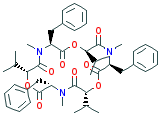|
BEAUVERICIN |
| Synonyms. Beauvericin; cyclo(D-alpha-Hydroxyisovaleryl-L-N-methyl-Phe)3; Cyclo((2R)-2-hydroxy-3- methylbutanoyl-N-methyl-L-phenylalanyl-(2R)- 2-hydroxy-3-methylbutanoyl-N-methyl-L- phenylalanyl-(2R)- 2-hydroxy-3-methylbutanoyl- N-methyl-L-phenylalanyl); |
|
|
| PRODUCT IDENTIFICATION | |
|
CAS RN |
26048-05-5 |
|
EINECS RN |
|
|
FORMULA |
C45H57N3O9 |
|
MOLE WEIGHT |
783.95 |
|
H.S CODE |
2941.90.1050 |
|
SMILES |
C(c1ccccc1)[C@@H]1C(O[C@@H](C(N(C)[C@@H](C(=O)O[C@@H](C(C) C)C(=O) N([C@@H](C(O[C@@H](C(N1C)=O)C(C)C)=O)Cc1ccccc1) C)Cc1 ccccc1)=O)C(C)C)=O; |
|
CLASSIFICATION |
Phytochemical, Depsipeptide |
|
EXTRA NOTES |
Biochem/physiol Actions: Beauvericin (BEA), a cyclohexadepsipeptide produced by the fungus Beauveria bassiana (Bals.), has antiviral, antibacterial, nematicidal, insecticidal, cytotoxic, and apoptotic activity.(sigmaaldrich) |
|
|
| PHYSICAL AND CHEMICAL PROPERTIES | |
|
PHYSICAL STATE. |
white powder |
|
MELTING POINT |
147 ~ 148 C |
|
BOILING POINT |
|
|
DENSITY |
|
|
SOLUBILITY IN WATER |
Slightly soluble |
| SOLVENT SOLUBILITY |
Soluble in methanol, ethanol, acetone, acetonitrile, hexane |
|
VAPOR DENSITY |
|
|
log P(octanol-water) |
|
|
VAPOR PRESSURE |
|
|
AUTOIGNITION TEMP |
|
| pK |
|
|
REFRACTIVE INDEX |
|
|
FLASH POINT |
|
|
|
| STABILITY AND REACTIVITY | |
| STABILITY | Stable under normal conditions. |
|
INCOMPATIBLE MATERIALS |
Strong oxidizing agents |
| POLYMERIZATION |
Has not been reported |
|
NFPA RATINGS |
Health: 1, Flammability: 0, Reactivity: 0 |
|
|
| EXTERNAL LINKS & GENERAL DESCRIPTION |
|
USA.gov - Beauvericin Wikipedia Linking - Beauvericin Google Scholar Search - Beauvericin U.S. National Library of Medicine - Beauvericin PubChem Compound Summary - Beauvericin KEGG (Kyoto Encyclopedia of Genes and Genomes) - Beauvericin http://www.ebi.ac.uk/chebi/ - Beauvericin http://www.ncbi.nlm.nih.gov/ - Beauvericin |
|
|
| SALES SPECIFICATION | |
|
APPEARANCE |
white powder |
|
ASSAY |
97% min |
|
MELTING POINT |
147 ~ 148 C |
|
LOSS ON DRYING |
1% max |
|
HEAVY METALS |
10ppm max |
|
|
| TRANSPORT & REGULATORY INFORMATION | |
|
UN NO. |
|
| HAZARD CLASS |
|
| PACKING GROUP | |
|
|
| SAFETY INFORMATION | |
|
HAZARD OVERVIEW |
GHS (Globally Harmonised System) Classification: Not a dangerous substance. Potential Health Effects: Eyes - May cause eye irritation. Skin - May be harmful if absorbed through skin May cause skin irritation. Inhalation - May be harmful if inhaled. May cause respiratory tract irritation. Ingestion - May be harmful if swallowed. |
| HAZARD CODES |
|
|
RISK PHRASES |
|
|
SAFETY PHRASES |
|
|
|
| PACKING |
|
Preserved in light-resistant and well-closed bottles |
|
|
